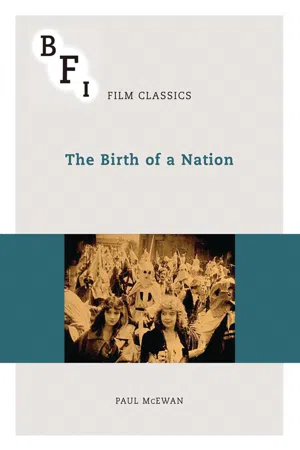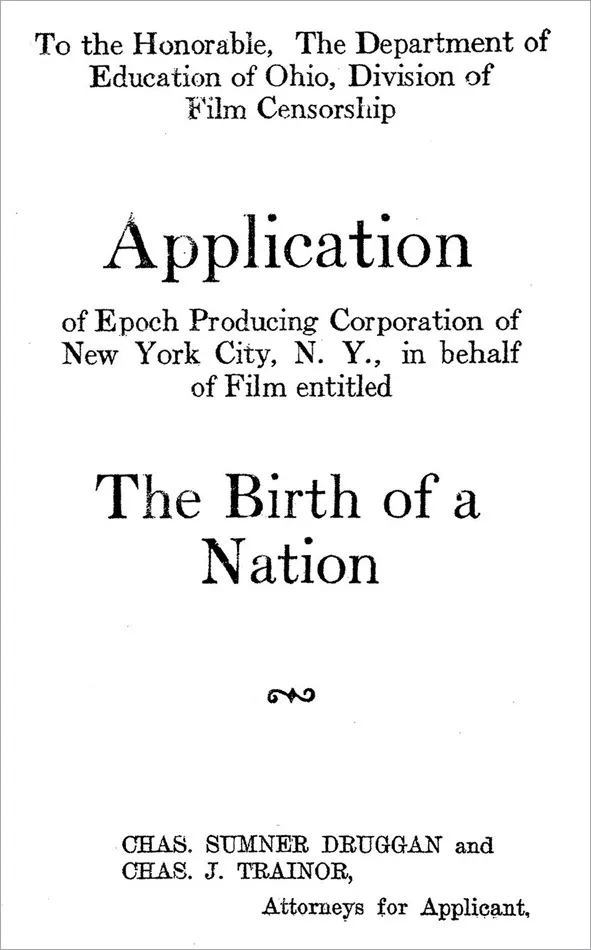![]()
1 The Film
Given how much would eventually be written about the film,8 the review of The Birth of a Nation in The New York Times on 4 March 1915, the day after its debut in the city, is remarkably succinct.9 Nevertheless, in fewer than three hundred words, the unsigned review manages to cover much that will be debated for the next century. Allowing that the film has an ‘ambitious scale’, the reviewer describes it as ‘a film version of some of the melodramatic and inflammatory material contained in “The Clansman,” by Thomas Dixon’, and remarks that ‘A great deal might be said concerning the spirit revealed in Mr Dixon’s review of the unhappy chapter of Reconstruction and concerning the sorry service rendered by its plucking at old wounds.’
The Birth of a Nation claims to be an accurate history of the Civil War and the period immediately afterwards, commonly known as the Reconstruction. It was made fifty years after the war and attempted to tell a story about the country’s darkest days, with the goal of unifying the nation and underscoring commonality rather than division. One hundred years later, it is of little use to us as a history of the Civil War or Reconstruction, but tells us a great deal about the time in which it was made. To modern eyes, it cannot be a unifying story, because its assumptions are so fundamentally racist. Griffith often argued that his film was not racist at all and was simply a true depiction of a difficult period in history, but the racism of the era in which he lived and worked was so deep, so endemic and so unremarkable to the vast majority of citizens that it was indeed invisible.
This is clear in the first proper intertitle of the film, which follows the titles and the defences of the motion picture: ‘The bringing of the African to America planted the first seed of disunion.’ The intertitle, and the quick shot that follows of a man in Puritan-style clothing raising his hands over a bound slave, makes it clear that the presence of African slaves in the United States was a problem because of the division it created among the white people of the country. The Birth of a Nation, despite its length and complexity, is fundamentally a story about brothers and sisters torn asunder who are reunited at the end. The entirety of the film leads towards the resolution of this narrative arc, when, under attack in the cabin, the partisans of North and South put their differences aside ‘in defence of their common Aryan birthright’. At the outset, the film introduces the ‘seeds of disunion’ that will fuel the conflict, but in terms of narrative function these seeds could just as well be something else – money or land or anything that causes a rift in a family. In this story, Africans are regarded as objects over which ‘people’ will fight, rather than as people in their own right with worthy desires or needs. For most of the film, the needs of the slaves or former slaves are limited to whatever can be conveniently provided by white overseers. Indeed, the only ‘positive’ portrayals of non-white characters in the film – the only ones who are not schemers or fools or racists – are the Camerons’ loyal servants, who defend their masters selflessly and attack less deferential blacks with what is supposed to be admirable fervour. Griffith used these characters to defend himself from attacks, writing that:
Title card from the beginning of the film; title: ‘The bringing of the African to America planted the first seed of disunion’
we do pay particular attention to those faithful Negroes who stayed with their former masters and were ready to give up their lives to protect their white friends. No characters in the story are applauded with greater fervor than the good Negroes whose devotion is so clearly shown. If prejudiced witnesses do not see the message in this portion of the entire drama we are not to blame.10
The title about the bringing of Africans to America also establishes a second notable feature of The Birth of a Nation – the forcefulness of its written narrative voice. The practice of writing intertitles varied greatly in the silent era, but for the most part the idea was to include as few as possible, which means that in general these titles are limited to dialogue and any necessary information that is not clearly conveyed by the images. Because The Birth of a Nation pushed the boundaries of narrative complexity in 1915, it is more dependent on intertitles than many silent films. Whatever else modern viewers might think about the film, it is not very difficult to follow, something that cannot be said about many other films of the period, including Griffith’s own Intolerance.
Griffith’s ‘faithful negroes’: Mammy defends Dr Cameron from mockery
The titles in The Birth of a Nation contain a strong narrative voice that directs the viewer’s attention and tells him or her what to think about the scenes that follow. The power of this voice is clear if we imagine rewriting many of the titles that belabour the villainy of the northern carpetbaggers and the noble virtues of the racists. It could never be a story about racial equality or understanding, since the racism is also so deeply embodied in the performances of white actors wearing blackface makeup, but its most extreme rhetoric could be greatly mitigated. In fact, the 1930 re-release of the film does exactly that at key moments – its intertitles are almost completely rewritten. The vast majority of the new titles simply rephrase the original content, but there are important modifications, including the title near the end about the ‘Aryan birthright’, which was changed to declare simply that the two sides were united against ‘the carpetbaggers’ mad folly’. Throughout the dramatically shortened (under two hours) 1930 re-release, which is the version many viewers saw for the next fifty years, the racist rhetoric is toned down and the film reads as much more of an action-adventure story and less of an epic history.11
Attention to the titles reminds us that much of the power of The Birth of a Nation lies in the interplay between what we see and what we read. If the common advice to novice writers and film-makers alike is to show rather than tell, The Birth of a Nation is a film that both shows and tells. As such, it is a key link between written and filmic storytelling, and a film that tries to maintain the historical authority of the written word while providing audiences with the thrill of visual immersion. This tension between written authority and the freedom of storytelling has played out in historical epic films up to the present day, although in nearly all subsequent cases the written authority becomes extra-textual, a part of the public relations campaigns for historical films advertising the attention to historical detail in the mise en scène, the amount of work that has gone into period costuming, or the attestations of experts or witnesses that a film is an accurate representation of its subject matter. Such extra-textual evidence surrounds films like Saving Private Ryan (1998), JFK (1991) or 12 Years a Slave (2013). In the case of The Birth of a Nation, it is also written directly into the film itself. Eager for it to be taken seriously as a work of history, Griffith included citations of written works throughout the film, arguing in one interview that in libraries of the future, rather than reading about history, patrons might be able to press a button and actually see what happened in a particular period.12
Such film boosterism misses the obvious fact that these library films would be subject to all of the same biases as written works, and also that narrative films are generally terrible at conveying the nuances of evidence in the way that historical writing can. Ideally, historical writing can clearly outline the evidence that exists for a particular idea or event, and rhetorically mark its own doubts and misgivings.13 Film cannot do any of these things without breaking continuity – within a scene, there is no way to indicate which lines of dialogue are part of the historical record and which are invented, or to convey the idea that evidence for an event is contradictory. This is why historical fiction films often try to coat themselves in a general sheen of historical accuracy by publicising the names of the veterans who were present for the filming of certain scenes or the research that went into the construction of sets. Such manoeuvres are the filmic equivalent of a book that contains a bibliography but no footnotes, providing assurance that research went into the production but eliding any discussion of the particulars and making it impossible for audiences to selectively evaluate the evidence.
Cover page for a collection of testimonials about the film to be used in an appeal to the Ohio state censor board, February 1925
The Birth of a Nation uses this confusion about evidence to great advantage, purposely blurring the line between what can be referenced and what is invented. The film is, of course, based on a novel and stage play rather than works of historical non-fiction, but it is important to note that, even if the core story is invented, the vast majority of historical works on the Reconstruction available in 1915 would have agreed with Griffith’s version of history. The prominence of what came to be known as the Dunning School (after William A. Dunning of Columbia University14) meant that Griffith and his lawyers could defend their film against charges of racism by referencing written academic histories. Griffith’s attorneys eventually produced an annotated bibliography for the film that was used in a court case in Ohio.15
The written references within The Birth of a Nation – to the biography of Lincoln by John George Nicolay and John Milton Hay,16 or to Woodrow Wilson’s A History of the American People – give the film a general sense of historical accuracy that carries over into other details, as in the scene on the Camerons’ plantation, where the title reads: ‘In the slave quarters. The two-hour interval given for dinner, out of their working day from six till six.’ Including such specific detail about working hours suggests careful research and is thus less likely to be questioned. Such rhetoric makes slavery sound reasonable, and indeed we see shots of slaves working contentedly and even dancing, rather than scenes of the physical violence upon which the institution depended. Slavery, of course, only provides a background to the story of the Camerons and the Stonemans, and it is the narrative form, rather than specific claims about slave life, that most convinces the viewer to align their sympathies with the slave owners rather than with the slaves themselves.
In his study of Griffith’s work in 1908 and 1909, Tom Gunning traces the development of the director’s film-making style, and argues that it is narrative that defines Griffith rather than individual camera shots or editing. As much as Griffith claimed credit for many formal advances,...





